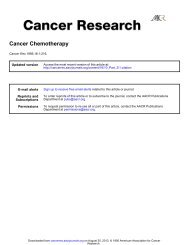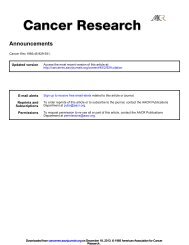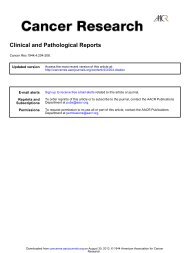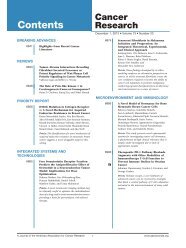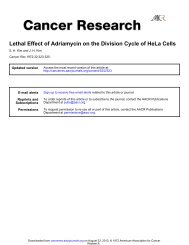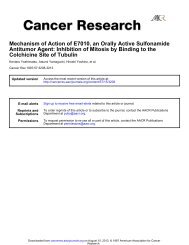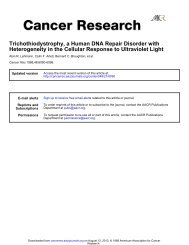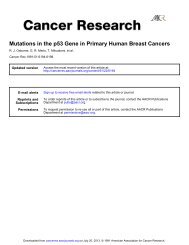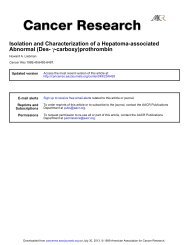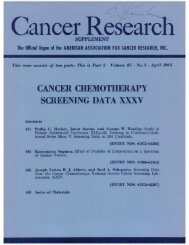THE INHERITABILITY OF SPONTANEOUS ... - Cancer Research
THE INHERITABILITY OF SPONTANEOUS ... - Cancer Research
THE INHERITABILITY OF SPONTANEOUS ... - Cancer Research
Create successful ePaper yourself
Turn your PDF publications into a flip-book with our unique Google optimized e-Paper software.
Downloaded from cancerres.aacrjournals.org on August 31, 2013. © 1916 American<br />
Association for <strong>Cancer</strong> <strong>Research</strong>.<br />
The Inheritability of Spontaneous Tumors of the<br />
Liver in Mice: Studies in the Incidence and<br />
Inheritability of Spontaneous Tumors in Mice:<br />
Seventh Report<br />
Maud Slye<br />
J <strong>Cancer</strong> Res 1916;1:503-522.<br />
Updated version<br />
Access the most recent version of this article at:<br />
http://cancerres.aacrjournals.org/content/1/4/503<br />
E-mail alerts Sign up to receive free email-alerts related to this article or journal.<br />
Reprints and<br />
Subscriptions<br />
Permissions<br />
To order reprints of this article or to subscribe to the journal, contact the<br />
AACR Publications Department at pubs@aacr.org.<br />
To request permission to re-use all or part of this article, contact the AACR<br />
Publications Department at permissions@aacr.org.
Downloaded from cancerres.aacrjournals.org on August 31, 2013. © 1916 American<br />
Association for <strong>Cancer</strong> <strong>Research</strong>.<br />
<strong>THE</strong> <strong>INHERITABILITY</strong> <strong>OF</strong> <strong>SPONTANEOUS</strong> TUMORS<br />
<strong>OF</strong> <strong>THE</strong> LIVER IN MICE1<br />
STUDIES IN <strong>THE</strong> INCIDENCE AND <strong>INHERITABILITY</strong> <strong>OF</strong> SPON-<br />
TANEOUS TUMORS IN MICE<br />
SEVENTH REPORT<br />
MAUD SLYE<br />
From the <strong>Cancer</strong> Laboratory of the Otho S. A. Spragw Memorial Institute and iAe<br />
University oj Chicago<br />
Received for publication, September 18, 1916<br />
The work of the past six years in this laboratory has definitely<br />
established two points in regard to the behavior of spontaneous<br />
cancer.<br />
I. CANCER IN GENERAL 18 INHERITABLE’<br />
This statement is based upon the following observations:<br />
(1) There are strains of mice in this laboratory which under<br />
no provocation have ever been made to produce spontaneous<br />
cancer.<br />
(2) There are other strains of mice which, under the right<br />
provocation, inevitably do produce cancer.<br />
(3) It is possible by selective breeding to manipulate these<br />
two types of mouse strains with the same certainty with which<br />
it is possible to manipulate pure-breeding pigmented mice and<br />
pure-breeding albinos, and to derive therefrom pure-breeding<br />
cancer strains and pure-breeding non-cancer strains.<br />
I say “cancer in general,” because until one has completely<br />
1 Presented before the American Association for <strong>Cancer</strong> <strong>Research</strong>, Washington,<br />
D. C., May, 1916.<br />
* For the sake of brevity I shall use the expression “inheritability of cancer,”<br />
although cancer is not transmitted as such; rather it is transmitted aa a<br />
tumor-producing potentiality. See introduction to Third Report, Jour. Med.<br />
<strong>Research</strong>, 1915, xxxii, 159.<br />
503
Downloaded from cancerres.aacrjournals.org on August 31, 2013. © 1916 American<br />
Association for <strong>Cancer</strong> <strong>Research</strong>.<br />
504 MAUD SLYE<br />
analyzed the reproductive potentialities of every individual concerned<br />
in the genealogy of a family, it is impossible to direct<br />
what shall be produced in any given case; and the resulting<br />
strain is likely to show sarcomas or carcinomas, adenomas or<br />
endotheliomas-of the ovaries, or of the mammary gland, or<br />
of the lung, or of the liver, or of any other organ. A family,<br />
therefore, manufactured by the hybridization of cancer-bearing<br />
with non-cancer-bearing individuals, will be peppered with<br />
tumors of different organs and of different types. Even<br />
after the cancer-bearing potentialities of two parents have<br />
been analyzed as completely as possible, we still discover in the<br />
offspring some divergence from the ancestral type. From such<br />
experiments carried on through years and in enormous numbers,<br />
yielding year after year perfectly consistent and logical results,<br />
no matter what strains are used, there is but one conclusion<br />
possible, namely, that this tumor-producing potentiality is a<br />
thing indubitably transmitted by the right selective breeding.<br />
11. TUMORS <strong>OF</strong> SPECIFIC ORGANS AND <strong>OF</strong> SPECIFIC TYPES ARE<br />
INHERITABLE<br />
That is, by selective breeding it is possible to derive strains<br />
of mice which yield a high percentage of lung tumor or of mammary<br />
gland tumor, or of liver tumor, or even of stomach and<br />
uterine tumors which are very rare in mice. And these strains<br />
of mice, again, can be manipulated, carrying into strains with<br />
which they are hybridized the types of tumors borne in their<br />
own ancestral line but from which the family with which they<br />
are crossed is perfectly free. A general survey of this field<br />
appears in the fifth report of these studies published in this<br />
issue.<br />
The present report concerns itself with the inheritability of B<br />
single class of these tumors of specific organs, namely, tumors<br />
of the liver.<br />
The data presented by a single strain or by many strains<br />
carrying a bigh percentage of mammary gland or of lung tumors<br />
when inbred, and introducing a high percentage of tumors of
Downloaded from cancerres.aacrjournals.org on August 31, 2013. © 1916 American<br />
Association for <strong>Cancer</strong> <strong>Research</strong>.<br />
<strong>SPONTANEOUS</strong> TUMORS <strong>OF</strong> <strong>THE</strong> LIVER IN MICE 505<br />
these same organs into every strain with which they are hybridized,<br />
might be contested on the ground of the frequency of these<br />
types of spontaneous tumors in mice, since about 90 per cent<br />
of all reported mouse tumors occur in these organs. Or the demonstration<br />
of a relatively high frequency of stomach or of uterine<br />
tumors in certain strains might fail to convince, because of<br />
the paucity of these tumors in mice.<br />
But tumors of the liver are of sufficient rarity in the literature<br />
to make an interesting study and are sufficiently frequent<br />
in this stock to make a most striking one. In all mouse literature<br />
outside of these studies there is but one tumor of the liver<br />
reported, namely, an adenoma reported by the Imperial <strong>Cancer</strong><br />
<strong>Research</strong> Fund of London (Third Report).<br />
This stock to date has furnished sixty-two primary tumors<br />
of the liver. These tumors are chiefly adenomas, with a sprinkling<br />
of sarcomas, and of carcinomas, and they are described<br />
fully in the Fourth Report of this series.3 It has furnished seventeen<br />
secondary tumors of the liver; these are mostly spindlecell<br />
and osteosarcomas, with a few carcinomas. All these primary<br />
liver tumors have fallen in strains of identical ancestry,<br />
namely, ancestry derived from Strain 90, and among all the<br />
other cancer-bearing strains, yielding twenty-five hundred primary<br />
neoplasms appearing in this stock, not one liver tumor<br />
has occurred. This fact furnishes a most striking piece of<br />
negative evidence for the inheritability of liver tumors.<br />
Chart 1<br />
Strains 280 and 281. These strains were produced by mating<br />
female No. 258, who died of a carcinoma of the lung but who<br />
came of a family carrying a heavy percentage of liver tumors<br />
(see Chart 8, Strain 202), with two brothers from Strain 90,<br />
namely, male No. 363 and male No. 286.<br />
1. Mated with male No. 363, who also had carcinoma of the<br />
lung, she produced a line of which 100 per cent carry tumor,<br />
80 per cent of these tumors being tumor of the lungs.<br />
Jour. Med. <strong>Research</strong>, 1915, xxxii, 171.
Downloaded from cancerres.aacrjournals.org on August 31, 2013. © 1916 American<br />
Association for <strong>Cancer</strong> <strong>Research</strong>.<br />
STRAIN -280. STRAIN-28 I.<br />
CHART 1<br />
Cucc LUNR D\ac LUNO<br />
PrnENT<br />
G3<br />
c4
Downloaded from cancerres.aacrjournals.org on August 31, 2013. © 1916 American<br />
Association for <strong>Cancer</strong> <strong>Research</strong>.<br />
<strong>SPONTANEOUS</strong> TUMORS <strong>OF</strong> <strong>THE</strong> LIVER IN MICE 507<br />
2. Mated with male No. 286 with an adenoma of the liver, she<br />
produced a line showing three cases of liver tumor in two generations,<br />
or 9 per cent of liver tumor. There was in this strain<br />
also an adenocarcinoma of the lungs, an adenoma of the lungs,<br />
and three lung nodules showing pre-adenomatous hyperplasia.<br />
Chart 2<br />
Strains 246 and 246. These strains were produced by mating<br />
male No. 286 (parent male also in Chart l), with an adenoma<br />
of the liver, with two sisters of Strain 48. Mated with female<br />
No. 412, who died of acute nephritis, he produced a strain showing<br />
over 44 per cent of tumor, with four straight generations of<br />
carcinoma of the mammary gland, three generations of adenoma<br />
of the lung, and one case of “fibro-endothelioma” of the ovary.<br />
Mated with the latter’s sister, female No. 26, with earcoma of<br />
the ovary, liver, kidney and mesentery,4 he produced a line showing<br />
tumor in 46 per cent of the individuals, and giving two<br />
generations of primary liver tumors.<br />
Note then, that in both instances where male No. 286 was<br />
mated with a female having a liver tumor, the resulting offspring<br />
showed a high percentage of liver tumor. When the same male<br />
was mated with a female without liver tumor no liver tumor<br />
appeared in the resulting strain although that strain carried a<br />
high percentage of tumor.<br />
Chart 3<br />
Strain $02. This chart is drawn to show both maternal and<br />
paternal ancestry, giving only the fraternities which are concerned<br />
in the production of liver tumors. The individuals of<br />
this strain and its“ancestry and of its sister strain, Strain 48<br />
(inbred) show nine cases of liver tumor among thirtyeight individuals,<br />
or liver tumor in nearly 24 per cent of the individuals; a<br />
tremendous percentage, considering the rarity of these tumors<br />
4 It is practically impossible in this case to say which of these sarcomas is<br />
primary but it is probable that the ovarian tumor is primary; hence the liver,<br />
kidney and mesenteric tumors have been classed as secondary.
Downloaded from cancerres.aacrjournals.org on August 31, 2013. © 1916 American<br />
Association for <strong>Cancer</strong> <strong>Research</strong>.<br />
508 MAUD SLYE<br />
c<br />
3<br />
8<br />
- ep<br />
lu 71<br />
CI m U 5
Downloaded from cancerres.aacrjournals.org on August 31, 2013. © 1916 American<br />
Association for <strong>Cancer</strong> <strong>Research</strong>.<br />
510 MAUD SLYE<br />
in mice. The construction of this strain involved the use of<br />
maternal and paternal ancestry from identical stock, carrying<br />
liver tumor. The potency of female No. 3 to transmit liver tumor<br />
is shown in strain after strain derived from her.<br />
Note here also that female No. 26 when inbred with her brother,<br />
male No. 814, with myocarditis, produced offspring with liver<br />
tumor, just as she did when hybridized with male No. 286 in<br />
Strain 245 (Chart 2). Note then: Female No. 258 (Chart 1)<br />
with lung carcinoma and coming from a strain rich in liver tumor<br />
mated with a male with lung carcinoma produced 80 per cent of<br />
lung tumor; the same female mated with male No. 286 with<br />
adenoma of the liver produced 9 per cent of liver tumor.<br />
Again, male No. 286 with adenoma of the liver mated with<br />
female No. 258, produced liver tumor; mated with female No. 26<br />
of Strain 48 (Chart 3), he produced liver tumor, while mated with<br />
female 412 without liver tumor and coming from a branch of the<br />
family rich in mammary gland tumor, he produced four generations<br />
of mammary gland tumor.<br />
Again, female 26 with sarcoma of the liver, outbred as above<br />
with male No. 286, with adenoma of the liver, produced liver<br />
tumor. Inbred with male No. 814, she produced liver tumor.<br />
The assumption of a chance determinant here is absurd where<br />
every individual parent is doubly or trebly checked as to his<br />
potentialities in the matter of liver tumor transmission.<br />
STRAIN 56<br />
EDEMA URINAW ACUTE ACUTC NCCROSII Aascrrs AOCNOMA<br />
0 LUN~S RETENTION INFECTION lNFFCTlON LIVER LIVER LIVLR<br />
GI<br />
02<br />
02<br />
CHART 4
Downloaded from cancerres.aacrjournals.org on August 31, 2013. © 1916 American<br />
Association for <strong>Cancer</strong> <strong>Research</strong>.<br />
<strong>SPONTANEOUS</strong> !l7JMORS <strong>OF</strong> <strong>THE</strong> LIVER IN MICE 51 1<br />
Chart 4<br />
Strain 69. This is another strain derived from female No. 3,<br />
crossed with a male from Strain 143 who died before autopsies<br />
were being made. Here again she produced offspring with adenoma<br />
of the liver. Strain 143 never showed liver tumor.<br />
Chart 6<br />
Strain 616. The parent of this strain, female No. 630, with<br />
metastatic carcinoma of the liver, is shown with her ancestry in<br />
Chart 3, second filial generation. She was crossed with male<br />
No. 721 of an allied line to make Strain 215. The resulting<br />
strain shows three cases of primary liver tumor in three successive<br />
generations.<br />
Chart 6<br />
Chart 6 shows a portion of Strain 215 with its parentage for<br />
six generations. The result is seven straight generations of<br />
tumor, three of these involving primary tumor of the liver.<br />
We come now to the consideration of a strain which alone has<br />
produced twelve cases of primary liver tumor, namely, Strain<br />
338. It is a strain manufactured during the last four years from<br />
stock deliberately selected to test the inheritability of tumor<br />
types, with emphasis upon liver tumors.<br />
1. It must be remembered that in work with mice, liver tumor<br />
can not be diagnosed until autopsy. In deliberately breeding to<br />
test the inheritability of liver tumor therefore, one is blind as to<br />
whether or not the individual selected will show it.<br />
2. It must be remembered again that in order to get sufhient<br />
numbers of offspring from the tested individuals for such a rare<br />
tumor as liver tumor, the selected mice must breed young. One<br />
must therefore frequently use mice which have not yet shown<br />
any tumor at all.<br />
3. The worker, then, must be guided by the ancestral history,<br />
and by the available data in the fraternities of the individuals<br />
selected for this test.<br />
In spite of all these handicaps note the results:
Downloaded from cancerres.aacrjournals.org on August 31, 2013. © 1916 American<br />
Association for <strong>Cancer</strong> <strong>Research</strong>.<br />
CNEPH LOCAL CNEW WOLMDS UNcrrrrur, UNCEF~TUW Aomomr<br />
STRAIN- 215.<br />
G5<br />
HIP LIVER<br />
LIVER<br />
Q I2207 Q 9595 6 7976 6 8138 6 8139 9 8871
Downloaded from cancerres.aacrjournals.org on August 31, 2013. © 1916 American<br />
Association for <strong>Cancer</strong> <strong>Research</strong>.<br />
<strong>SPONTANEOUS</strong> TUMORS <strong>OF</strong> <strong>THE</strong> LIVER IN MICE 513<br />
ANCESTRY: STRAIN-215.<br />
SARC M GL<br />
MALIG ADENOMA<br />
9 3 LIVER 6360<br />
UNCERTAIN<br />
-n-<br />
I-<br />
I<br />
CARC. M GL<br />
PUL.INF<br />
Q5 METAS LUNQS<br />
CARC M GL<br />
METAS LUNGS<br />
C NEPH<br />
I<br />
LUNGS<br />
9 lLIVER 8871 618139<br />
CHART 6<br />
Chart 7<br />
Strain 112. The parent female of this liver tumor strain, Strain<br />
338, was female No. 5417. She presented no evidence of liver<br />
tumor but was selected to start Strain 338 after the appearance of<br />
her mammary gland carcin0m.a. She had six litters of young after<br />
the appearance of her tumor and is one of the individuals previously<br />
reported (Third Report, p. 193), in whom tumor growth
Downloaded from cancerres.aacrjournals.org on August 31, 2013. © 1916 American<br />
Association for <strong>Cancer</strong> <strong>Research</strong>.<br />
STRAIN-112<br />
CHART 7<br />
I<br />
WOUNDS CNEPH SS CARC<br />
NECK<br />
5156 Q 5758 Q 7690<br />
Q3<br />
G PARENT<br />
LABOR L ~ O R VNCERTAI UNCERTAIN CNEPH CNEPH<br />
Q 1332 Q 1250 62512 Q 3581 Qi5333 Q 5859<br />
I<br />
PYELO - WOUNDS WOUNDS SaRc LIVER CAac M GL<br />
NEPH CNEPH CARC Rivis G2<br />
639426400664018 Q Q 5305 Q 5417 METAS LUNGS<br />
G3
uvER<br />
61~~R0505<br />
TAPEWOR,..<br />
"'·a<br />
ANCESTRY - STRAIN 3~e.<br />
SA OC M GL ICWO.N 'C<br />
MAI..JGAocfWf'tA .i. N E~<br />
Downloaded from cancerres.aacrjournals.org on August 31, 2013. © 1916 American<br />
Association for <strong>Cancer</strong> <strong>Research</strong>.
Downloaded from cancerres.aacrjournals.org on August 31, 2013. © 1916 American<br />
Association for <strong>Cancer</strong> <strong>Research</strong>.<br />
<strong>SPONTANEOUS</strong> TUMORS <strong>OF</strong> <strong>THE</strong> LIVER IN MICE 515<br />
was greatly retarded by constant pregnancy. She lived nearly<br />
a year after the appearance of her mammary gland carcinoma and<br />
showed at autopsy an additional carcinoma of the pelvis and<br />
lungs riddled with metastases. Indeed, at the time of her death<br />
the mouse was about one-half carcinoma.<br />
The place of this female within her inbred strain is shown in<br />
Chart 7, second filial generation. It will be noted that her<br />
grandmother, female No. 3920, had adenoma of the liver, and<br />
that her sister born in the same litter, female No. 5305, had sarcoma<br />
of the liver. Inbred with her brother, male No. 3942,<br />
with pyelo-nephritis, she produced mammary gland and neck<br />
carcinoma with metastases in the lungs.<br />
Chart 8<br />
Strain 124. The paternal parent of Strain 338 was male No.<br />
7736. He was selected as the strongest remaining representative<br />
of strain 124, which had liver tumor ancestry behind it.<br />
His great-aunt, female No. 1070, had adenoma of the liver.<br />
His immediate family at the time he was selected showed 25<br />
per cent of cancer, but no liver tumor.<br />
He himself lived to be three years and three months old. He<br />
died of arterial sclerosis, and showed at autopsy a papilloma of<br />
the lung.<br />
His place in his inbred strain is shown in Chart 8, Branch 11,<br />
filial generation 3.<br />
Chart 9<br />
Chart 9 is drawn to show the complete ancestry which lay<br />
behind these two parents, namely, female No. 5417and male No.<br />
7736.<br />
Ancestry offemale No. 6417. Five generations back her grandparents<br />
were female No. 3, with a malignant adenoma of the<br />
liver, inbred with her brother, male No. 30. with chronic nephritis<br />
(these original forbears were members of Strain 90).<br />
The male in her maternal line, and the female in her paternal<br />
line, were the immediate offspring of this pair, the female No.<br />
I
Downloaded from cancerres.aacrjournals.org on August 31, 2013. © 1916 American<br />
Association for <strong>Cancer</strong> <strong>Research</strong>.<br />
BRANCH -It<br />
BRANCH -I<br />
STRAIN- 124.<br />
-I-<br />
I
Downloaded from cancerres.aacrjournals.org on August 31, 2013. © 1916 American<br />
Association for <strong>Cancer</strong> <strong>Research</strong>.<br />
<strong>SPONTANEOUS</strong> TUMORS <strong>OF</strong> <strong>THE</strong> LIVER IN MICE 517<br />
.<br />
883 having adenoma of the liver. Hybridization in this generation<br />
was with Granby, Mass., red stock, namely, female No. l,<br />
female No. 24 and male No. 27, which never in my hands produced<br />
liver tumor, primary or secondary, either in inbreeding or<br />
in hybridization with non-liver tumor strains. Female No. 1,<br />
however, carried carcinoma, and male No. 27 had abscess of the<br />
liver.<br />
The parent female two generations back, female No. 3920, had<br />
adenoma of the liver and the male, No. 3024, had an infected<br />
lung nodule and chronic nephritis.<br />
There were, then, behind the female, three generations of liver<br />
tumor and an ancestry carrying a' considerable percentage of<br />
cancer, with a tendency of the liver to yield to disease. The<br />
origin of both branches of the ancestry was female No. 3 with<br />
an adenoma of the liver which appeared later in both sides of<br />
the family. These facts determined the selection of female No.<br />
5417, who at the time of her selection had a very small carcinoma<br />
of the mammary gland and was in excellent breeding<br />
shape.<br />
Ancestry of male No. 7736. The original forebears of this line<br />
also five generations back were female No. 3 with her adenoma<br />
of the liver, and her brother, male No. 30, both long lived.<br />
Again, on both sides of this line also, a double dose of the<br />
immediate offspring of female No. 3 was introduced, namely,<br />
female No. 73 with carcinoma of the lung and male No. 752 with<br />
liver necrosis.<br />
Here as in the maternal line there was a considerable percentage<br />
of tumor, a reappearance of adenoma of the liver in the<br />
strain, and a tendency of the liver to yield to disease. There<br />
were then two generations of liver tumor behind male No. 7736,<br />
and three generations of liver tumor behind female No. 5417.<br />
Two adenomas of the liver appeared in the first filial generation<br />
from this cross, namely, female No. 9544 and male No. 8751.<br />
The rest of the chart shows Branch .K,.fr~m,~hjg,q~ss, bred<br />
out in five lines, the female parent o f . t ~ ~ ~ ~ ~ ~ 8619, ~ ~ ' i ' f i ~ ~ ~<br />
showing two carcinomas 05 ,$?+.qapppv gImd,.a& t+ ..tq@.e<br />
parent of the branch, malei~~;,~7~~~*~~*~den~.~~.t~liJer.<br />
..............<br />
:,*<br />
:..::*:. . -.:<br />
*.a. .<br />
.......
Downloaded from cancerres.aacrjournals.org on August 31, 2013. © 1916 American<br />
Association for <strong>Cancer</strong> <strong>Research</strong>.<br />
518 MAUD SLYE<br />
In the second filial generation there were three tumors of the<br />
liver, namely, one sarcoma and two adenomas.<br />
In the third filial generation also there were three liver tumors,<br />
all adenomas.<br />
Note that these liver tumors all fell within two lines from this<br />
mating, namely, lines A and D. Note also line C, of which<br />
100 per cent shows carcinoma, all of the mammary gland and of<br />
the lung; where the parent female had carcinoma of the mammary<br />
gland and the parent male had carcinoma of the lung.<br />
Chart 10<br />
Branch IX of Strain 338. This branch is derived, of course,<br />
from identical ancestry with Branch V, as shown in Chart 9.<br />
Here also there are two generations of primary liver tumor.<br />
Chart I1<br />
Branches XI1 and XI11 of this same strain show also an outcropping<br />
of primary liver tumor in the fourth filial generation, a<br />
lymphosarcoma in female No. 12212, and an adenoma in female<br />
No. 11245.<br />
Chart 12<br />
Parts of Strains 465 and 460. This chart is introduced to<br />
show how in hybridization also Strain 338 and its sister strain,<br />
Strain 465, produced liver tumor.<br />
Two sisters, female No 5305 and female No. 5417, were mated<br />
with two half-brothers, male No. 5215 and male No. 7736. Note<br />
the outcropping of liver sarcomas, along with the stomach tumors,<br />
in the third and fourth filial generations in each case.<br />
Let me review the striking points demonstrated by these<br />
charts :<br />
1. A great many strains have been carried for years in this<br />
laboratom.&lfi@g .yaying percentages of cancer, some of them<br />
as highi.%&,$Qp &x@&ti .$$..never showing liver tumor, primary<br />
.oy.$econdaqy., 9These.strqips hvdaeen carried side by side with<br />
.the;%$& $,$qbr, .&tra,ii~bj$ $$&$andled with identical tech-<br />
..............<br />
..: :*. a.: ..::<br />
:<br />
...........<br />
..............
Downloaded from cancerres.aacrjournals.org on August 31, 2013. © 1916 American<br />
Association for <strong>Cancer</strong> <strong>Research</strong>.<br />
CHART 10<br />
1-<br />
PNEUMONIA<br />
9 12172<br />
BR~NCH x<br />
G.PARENT<br />
STRAIN 338<br />
z CARC. M.GL PAPILLOMA LUNG<br />
ARTERIAL SCLEROSIS.<br />
B<br />
W<br />
G. 1<br />
~ADENOMA<br />
G. z b 9518<br />
TAPEWORM<br />
THYMUS. KIDNEY<br />
LIV~. CYSTS.<br />
SQCLLLCARC FACE ~NK,~NF. SARCOMA<br />
[SITE <strong>OF</strong> WOUNDl<br />
METAS.DIAPHRAGM ? 12386 0 12138 ? 11828 8 68.34<br />
G.3<br />
ADENOMA LUNG
Downloaded from cancerres.aacrjournals.org on August 31, 2013. © 1916 American<br />
Association for <strong>Cancer</strong> <strong>Research</strong>.<br />
G.PARENT-<br />
G. i<br />
G.2<br />
63
Downloaded from cancerres.aacrjournals.org on August 31, 2013. © 1916 American<br />
Association for <strong>Cancer</strong> <strong>Research</strong>.<br />
PARTS Of STRAINS 405 AN0 480 WITH ANCCSTRX %OWING OCCURRENC<br />
Srorucrr TUMO<br />
CHART 12<br />
~NTUTlNAL~NFtCTlO<br />
nc.Lu~~. ADENC++ALWCR
Downloaded from cancerres.aacrjournals.org on August 31, 2013. © 1916 American<br />
Association for <strong>Cancer</strong> <strong>Research</strong>.<br />
522 MAUD SLYE<br />
nique, and hybridized with identical non-liver tumor strains, thus<br />
eliminating every possible cause for this divergence except<br />
heredity.<br />
2. One cancer bearing strain, Strain 90, has been used either in<br />
inbreeding or in hybridization (a) in the origin of every strain in<br />
this laboratory which has ever produced a primary tumor of the<br />
liver; (b) in the origin of every strain which has ever furnished a<br />
secondary tumor of the liver, with the exception of two osteosarcomas<br />
which metastasized in practically every organ in the<br />
body.<br />
3. One individual female, No. 3, with a malignant adenoma of<br />
the liver and a sarcoma of the mammary gland, stands out preeminently<br />
in this production of liver tumor. Either she or her<br />
immediate offspring has been used in one or both origins of<br />
every strain which has ever produced a liver tumor, primary or<br />
secondary, in this laboratory, with the exception of the two<br />
metastatic osteosarcomas noted above.<br />
The emergence of liver tumor in these hybrid strains derived<br />
from female No. 3, or her immediate offspring, frequently takes<br />
place years after the death of their liver tumor progenitors,<br />
thereby eliminating every possibility of a contact transmission<br />
of this disease even in the nature of a germ plasm infection.<br />
4. Certain individuals, both when inbred anti when outbred<br />
and when tested with many mates, consistently show liver<br />
tumor in every resulting strain.<br />
Consider (1) that outside of this stock there is just one liver<br />
tumor recorded among all the thousands of mouse tumors, (2),<br />
that these results are deliberately produced by the manipulatioii<br />
of selective breeding alone, (3) that they have consistently occurred<br />
for years in every test made, (4) that there are over<br />
twenty-five hundred primary neoplasms, and over fourteen thousand<br />
individuals involved in this perfect and persistent consistency.<br />
What explanation remains but that of heredity?




